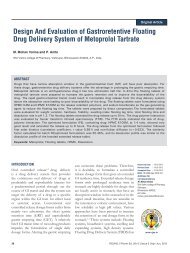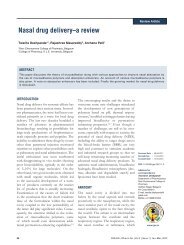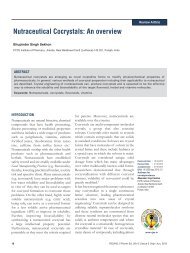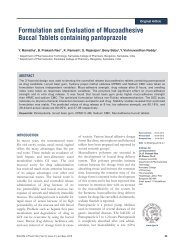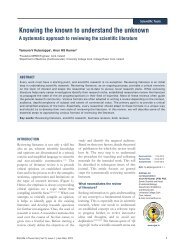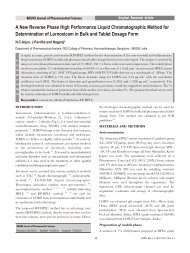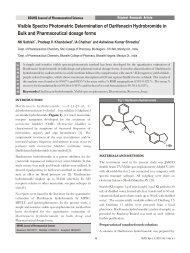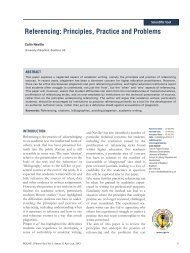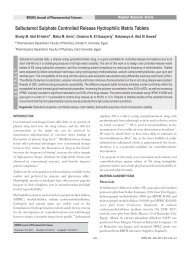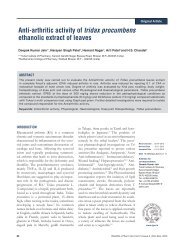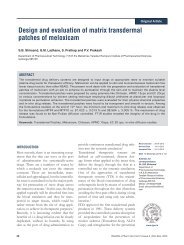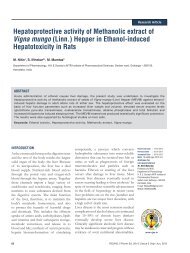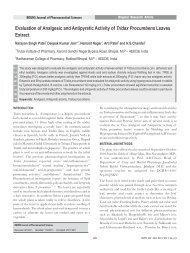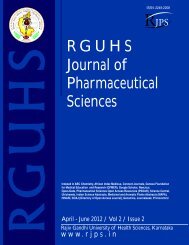Chitosan Loaded Mucoadhesive Microspheres of Gliclazide - Journal
Chitosan Loaded Mucoadhesive Microspheres of Gliclazide - Journal
Chitosan Loaded Mucoadhesive Microspheres of Gliclazide - Journal
You also want an ePaper? Increase the reach of your titles
YUMPU automatically turns print PDFs into web optimized ePapers that Google loves.
polymer-to-drug ratio respectively, have shown good<br />
correlation coefficient 0.9984. Results <strong>of</strong> the equation<br />
indicate that the effect <strong>of</strong> (X ) polymer-to-drug ratio is more<br />
1<br />
significant than (X ) stirring speed. However stirring speed has<br />
2<br />
a negative effect on drug entrapment efficiency, hence the<br />
stirring speed increased, the particle size decreased, and the<br />
drug entrapment efficiency has also decreased. The particle<br />
size <strong>of</strong> the mucoadhesive microspheres <strong>of</strong> chitosan varied<br />
from 50 to 98 µm and has shown good correlation coefficient<br />
0.9878. However stirring speed has a negative effect on<br />
particle size, thus the stirring speed increased, the particle<br />
sizes decreased.<br />
2<br />
Y= 67.1 + 4.69 X1 - 4.47 X2 - 0.98 X2 - 0.98 X1 X2<br />
Factorial equation for percentage mucoadhesion<br />
and swelling index<br />
The in vitro wash-<strong>of</strong>f test for percentage mucoadhesion <strong>of</strong><br />
chitosan loaded mucoadhesive microspheres after 1 hour<br />
varied from 43% to 52%, 62% to 78% and 67% to 80% at<br />
lower, medium and higher levels <strong>of</strong> polymer-to-drug ratio and<br />
has shown good correlation coefficient 0.9803. However<br />
stirring speed has a negative effect on percentage<br />
mucoadhesion. As the polymer-to-drug ratio increases, the<br />
percentage mucoadhesion also increases; because more<br />
amounts <strong>of</strong> polymer results in higher amount <strong>of</strong> free-COOH<br />
groups, which are responsible for binding with sialic acid<br />
groups in mucus membrane and thus results in increase in<br />
mucoadhesive properties <strong>of</strong> microspheres. In vitro<br />
mucoadhesive test has shown that gliclazide mucoadhesive<br />
microspheres adhered more strongly to gastric mucous layer<br />
and would retain in gastrointestinal tract for an extended<br />
period <strong>of</strong> time were shown in (Fig.1).<br />
2<br />
Y= 77.81 + 15.78 X1 - 6.91 X2 - 9.98 X2 - 2.1X1 X2<br />
A Senthil et al./ <strong>Chitosan</strong> <strong>Loaded</strong> <strong>Mucoadhesive</strong> <strong>Microspheres</strong> <strong>of</strong> <strong>Gliclazide</strong>: In vtro and In vivo Evaluation<br />
The microspheres (100) were suspended in 5 mL <strong>of</strong> simulated<br />
gastric fluid USP (pH 1.2). The particle size would be<br />
monitored by microscopy technique every 1 hour using an<br />
optical microscope. The increase in particle size <strong>of</strong> the<br />
microspheres would be noted up to 8 hours. The swelling<br />
index <strong>of</strong> chitosan varied from 0.812 to 1.412. Surface graphs<br />
showing effect <strong>of</strong> variables on % mucoadhesion, drug<br />
entrapment efficiency, swelling index and particle size for<br />
optimized batch were shown in (Fig. 2). <strong>Chitosan</strong> could be<br />
covalently cross-linked with glutaraldehyde through its amino<br />
groups. The aldehyde groups <strong>of</strong> the glutaraldehyde formed<br />
covalent imine bonds with the amino groups <strong>of</strong> chitosan, due<br />
to the resonance established with the adjacent double<br />
ethylenic bonds via a Schiff reaction. It is reflects that<br />
polymeric chains during cross-linking procedure, the extent<br />
<strong>of</strong> the swelling index depends on the cross-linking. Therefore,<br />
167<br />
Fig. 1: In vitro Wash-Off Test Carried out on <strong>Gliclazide</strong><br />
<strong>Loaded</strong> <strong>Chitosan</strong> <strong>Mucoadhesive</strong> <strong>Microspheres</strong> (batch A4),<br />
using Rat Stomach<br />
Figure 2: Surface Graphs Showing Effect <strong>of</strong> Variables on<br />
(1) % Mucoadhesion (2) Drug Entrapment Efficiency<br />
(3) Swelling Index (4) Particle Size for Optimized Batch (A4).<br />
1 2<br />
3 4<br />
the denser the cross-linking bridges between the chitosan<br />
molecules, the more packed is the structure. Such structure<br />
can be characterized by lower and slower penetration <strong>of</strong> the<br />
solvent through the chain structure <strong>of</strong> the polymer, suggesting<br />
that the swelling ratio and hence the release characteristics <strong>of</strong><br />
the microspheres can be controlled by varying the content <strong>of</strong><br />
the cross-linking agent used during the manufacturing<br />
process. Since glutaraldehyde is responsible for the formation<br />
<strong>of</strong> cross-links, increasing the amount <strong>of</strong> glutaraldehyde and<br />
RJPS, Jul - Sep, 2011/ Vol 1/ Issue 2



